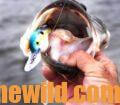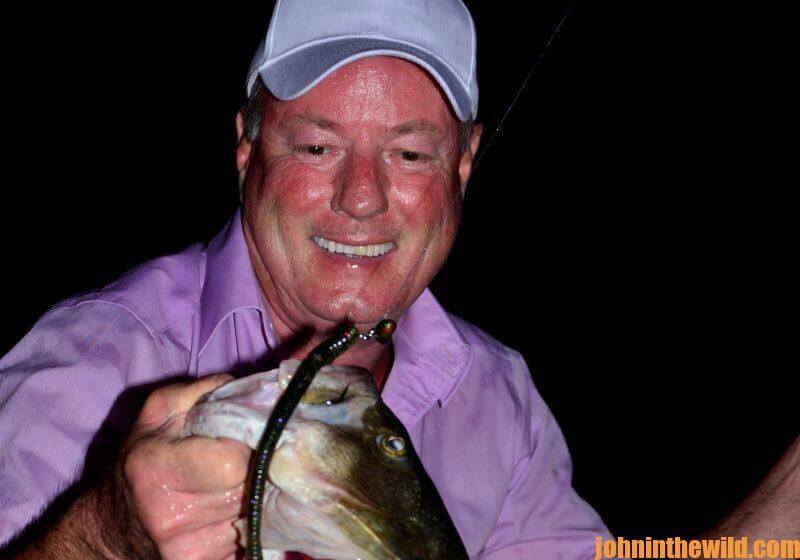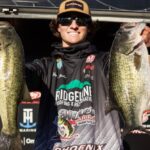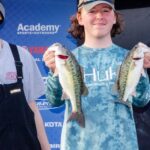Editor’s Note: Captain Phillip Criss of Scottsboro, Alabama, has been a more-than a three-decade fishing buddy of mine for both bass and crappie – first at Miller’s Ferry and now at Lake Guntersville (www.guntersvilleal.org) on the Tennessee River in north Alabama. Anglers across the South know of Criss’s bass-fishing expertise. Since he’s retired from his day job to move to Guntersville to guide and fish, in mid-July, I went fishing with him. Criss gave me valuable information on fishing grassy lakes in hot weather. Guntersville is known as one of the top-5 bass-

fishing lakes in the nation, primarily because of its grassy habitat that produces and grows bass.
“All the fish seemed to have died,” Captain Phillip Criss, a bass fishing guide on Lake Guntersville, told me. Two days before I was to arrive and fish with him, Criss had caught some really-nice bass at Guntersville. When I got to Criss’s house, he was still upset about the bass that we were supposed to use for photography dying before I arrived. “I guess we’re going to find out what kind of guide I really am,” Criss told me. “We’ll have to catch some bass quickly, if we’re going to have fish to photograph.”
With only 2 hours before dark, we raced down Lake Guntersville and started fishing about 150 yards from shore. “There’s an old roadbed that comes up to about 8 feet on top and drops off to

about 16 feet on either side of the roadbed,” Criss explained. “This roadbed was built back in the Civil War and was used to carry supplies to ships out on the main river. Late in the evening, bass school-up on top of the roadbed to feed on shad. But when they’re not schooling, they’ll usually be holding off the side of the roadbed in deeper water. I’m going to fish a swimbait, and I want you to fish a shaky head worm.”
The only shaky head worms I ever had fished before were pencil-thin, straight-tail worms – each with a ballhead jig to make the worm stand-up on the bottom. The shaky head that Criss rigged up for me was a really weird-looking Zoom Magnum black Trick Worm (www.zoombait.com) on a No. 5/0

hook and 20-pound-test line. The eye of the hook went through a second eye that held a 1-ounce Gene Larew HardHead football head jig (www.genelarew.com). I could cast the bait out a long way. Within the first five casts with this crazy-looking shaky head worm, I got a strike. I set the
hook and fought a 6-pound largemouth to within 10 yards of the boat. Then the bass went airborne and threw my shaky head worm. Five minutes later, using the same worm, I caught and boated a 6 pounder. Before dark, Criss and I had eight bass in the boat that weighed from 3-1/2 to 6-pounds.
Criss has been bass fishing since he was 12-years old. Originally, he started guiding on the Alabama River near Gee’s Bend at Miller’s Ferry. He’s been fishing Guntersville Lake for almost two decades. When he retired, he moved to Guntersville. Within a very short time, he established himself as one of the best bass guides on the lake. “My wife and I moved to Guntersville, because of the quality of bass we could catch and the size of the lake. I don’t know of any other place I’ve ever fished that I consistently can catch 4- or 5-pound bass every day I fish. On an average day with two clients, the best five bass we’ll catch for the day will weigh around 25 pounds – that’s a 5-pound per bass average. We’ve even had days when our best five would weigh 30 to 35 pounds. I’ve had several days when I’ve caught and
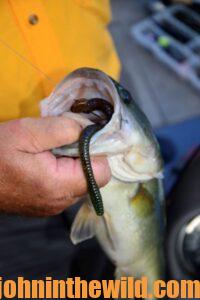
released over 100 bass in one day. On an average day, we expect to catch and release 20 to 40 bass. Our fish will usually run from 3 pounds up to about 7-1/2-pounds or bigger. And, there’s plenty of 10-pound-bass plus at Guntersville, but we don’t catch them every day.
“From the end of July, through about the middle of October, we’ll primarily fish this big shaky head worm on the football head jig in a grassy lake like Guntersville. I like from 1/2-ounce up to 1-1/4 ounce jig heads. I’ll use the bigger jig head if I’m fishing on the main river ledge, and there’s a lot of current coming through the lake. The football head jig is a Gene Larew HardHead jig. It isn’t attached to the hook. There’s a metal loop on the end of the football head, and the eye of the hook runs through the metal loop. So, the Zoom Magnum Trick Worm moves independently of the lead head. I’ve really fallen in love with this trick worm that’s 8-12 inches long. I particularly like green-pumpkin and the watermelon-candy colors in the summer.
“John, the worm you’ve caught all your fish on is watermelon-candy and is a worm with a somewhat bigger tail. This worm isn’t designed to be fished on the bottom. Most trick worms are used like twitch baits. You twitch them along the surface of the water. The worm sinks very slowly, so you can let it fall into cover and then

twitch it up out of cover. This Magnum Trick Worm has a lot of buoyancy, and it’ll float-up off the bottom. I dye the tails chartreuse. If any current is coming through the lake, the current gives the worm the action, and the worm will wiggle and flop around like a live worm. But if you’re fishing dead water where there’s no current, you can shake your rod tip, and that worm comes alive on the bottom. Because the worm is not directly attached to the football head jig, the front of the worm moves as much as the back of the worm. Most of the time, I’ll be fishing this worm on 14- to 17-pound-test monofilament line. This tactic pays off in hot-weather grassy lakes.”
Here’s the reason I missed the first 6-pound bass that took my shaky head worm. As I was dragging the worm across the bottom, I felt additional weight on the line. I told Criss, “I think I’m dragging a tree limb.” “Set the hook,” Criss yelled. After the bass got off my line, Criss explained. “Here on Lake Guntersville like other gras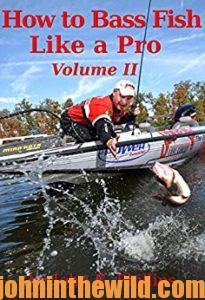 sy lakes in hot weather, when a bass takes that trick worm, you won’t get a violent strike. The worm just will feel heavier than it has the last time you’ve pulled it, or you may feel a slight tick on the line like a bream has attacked the tail of the bait. Then you have to set the hook and set it hard.”
sy lakes in hot weather, when a bass takes that trick worm, you won’t get a violent strike. The worm just will feel heavier than it has the last time you’ve pulled it, or you may feel a slight tick on the line like a bream has attacked the tail of the bait. Then you have to set the hook and set it hard.”
To contact Captain Phillip Criss about fishing Lake Guntersville, call him at 205-461-5549, or email him at [email protected].
To learn more about bass fishing, check out John E. Phillips’ book, “How to Bass Fish Like a Pro, Volume II,” available in Kindle, print and Audible versions at https://www.amazon.com/gp/product/B08Z9W6VC1/ref=dbs_a_def_rwt_hsch_vapi_taud_p1_i9.To learn more about hunting for deer, since the season’s  starting soon in many states, check out John E. Phillips’ “Bowhunting Deer: Mossy Oak Pros Know Bucks and Bows” available in Kindle, print and Audible as of August, 2022, at (http://amzn.to/1QGvdQx) You may have to copy and paste these clicks into your browser. When you click on these books, notice on the left where Amazon says you can read and hear 10% of the books for free. On right side of the page and below the offer for a free Audible trial, you can click on Buy the Audible with one click.
starting soon in many states, check out John E. Phillips’ “Bowhunting Deer: Mossy Oak Pros Know Bucks and Bows” available in Kindle, print and Audible as of August, 2022, at (http://amzn.to/1QGvdQx) You may have to copy and paste these clicks into your browser. When you click on these books, notice on the left where Amazon says you can read and hear 10% of the books for free. On right side of the page and below the offer for a free Audible trial, you can click on Buy the Audible with one click.
Tomorrow: Use Deep-Diving Crankbaits for Summer Bass


